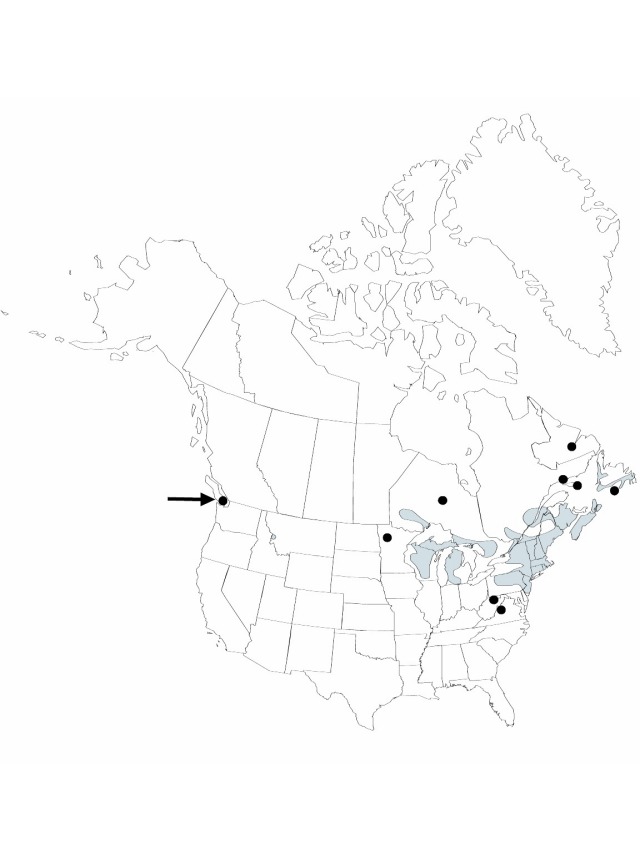Difference between revisions of "Potamogeton oakesianus"
in A. Gray,Manual of Botany of the Northern United States (ed. 5) 485. 1867.
FNA>Volume Importer |
FNA>Volume Importer |
||
| Line 24: | Line 24: | ||
|elevation=50–1500 m | |elevation=50–1500 m | ||
|distribution=St. Pierre and Miquelon;B.C.;N.B.;Nfld. and Labr.;N.S.;Ont.;Que.;Conn.;Maine;Mass.;Mich.;Minn.;Mont.;N.H.;N.J.;N.Y.;Pa.;R.I.;Vt.;Va.;W.Va.;Wis. | |distribution=St. Pierre and Miquelon;B.C.;N.B.;Nfld. and Labr.;N.S.;Ont.;Que.;Conn.;Maine;Mass.;Mich.;Minn.;Mont.;N.H.;N.J.;N.Y.;Pa.;R.I.;Vt.;Va.;W.Va.;Wis. | ||
| − | |discussion=<p>Potamogeton oakesianus, along with Potamogeton floridanus and P. natans, has floating leaves and phyllodial submersed leaves. The petioles of this species and of P. floridanus lack a short area of light-colored tissue immediately proximal to the blade.</p> | + | |discussion=<p><i>Potamogeton oakesianus</i>, along with <i>Potamogeton floridanus</i> and <i>P. natans</i>, has floating leaves and phyllodial submersed leaves. The petioles of this species and of <i>P. floridanus</i> lack a short area of light-colored tissue immediately proximal to the blade.</p> |
|tables= | |tables= | ||
|references= | |references= | ||
| Line 48: | Line 48: | ||
|publication year=1867 | |publication year=1867 | ||
|special status= | |special status= | ||
| − | |source xml=https://jpend@bitbucket.org/aafc-mbb/fna-data-curation.git/src/ | + | |source xml=https://jpend@bitbucket.org/aafc-mbb/fna-data-curation.git/src/8f726806613d60c220dc4493de13607dd3150896/coarse_grained_fna_xml/V22/V22_133.xml |
|genus=Potamogeton | |genus=Potamogeton | ||
|species=Potamogeton oakesianus | |species=Potamogeton oakesianus | ||
Revision as of 15:55, 18 September 2019
Rhizomes present. Cauline stems terete, with red spots, 7–75 cm; nodal glands absent. Turions absent. Leaves both submersed and floating, ± spirally arranged. Submersed leaves sessile, lax; stipules persistent, conspicuous, convolute, free from blade, whitish, not ligulate, 1–3 cm, delicately fibrous, not shredding at tip, apex obtuse; blade pale green, linear to phyllodial, not arcuate, 5–16 cm × (0.25–)0.3–1 mm, base slightly tapering, without basal lobes, not clasping, margins entire, not crispate, apex acute, not hoodlike, lacunae absent, setaceous; veins 3. Floating leaves: petioles continuous in color to apex, 3.2–7.5 cm; blade adaxially light to dark green, lanceolate to elliptic or ovate, (1.5–)2–4(–5.5) cm × 10–20(–30) mm, base rounded or tapering, apex acute; veins (7–)9–19(–23). Inflorescences unbranched, emersed; peduncles not dimorphic, terminal, ascending to spreading, cylindric, 2.5–8 cm; spikes not dimorphic, cylindric, 10–35 mm. Fruits sessile, greenish brown, obovoid, turgid, abaxially keeled, laterally keeled, 2.5–3.5(–3.7) × (1.6–)2–2.4 mm, lateral keels without points; beak erect, 0.4–0.8 mm; sides without basal tubercles; embryo with 1 full spiral. Chromosome number apparently unknown.
Phenology: Flowering summer–fall.
Habitat: Quiet acidic waters of bogs, ponds, and lakes
Elevation: 50–1500 m
Distribution

St. Pierre and Miquelon, B.C., N.B., Nfld. and Labr., N.S., Ont., Que., Conn., Maine, Mass., Mich., Minn., Mont., N.H., N.J., N.Y., Pa., R.I., Vt., Va., W.Va., Wis.
Discussion
Potamogeton oakesianus, along with Potamogeton floridanus and P. natans, has floating leaves and phyllodial submersed leaves. The petioles of this species and of P. floridanus lack a short area of light-colored tissue immediately proximal to the blade.
Selected References
None.